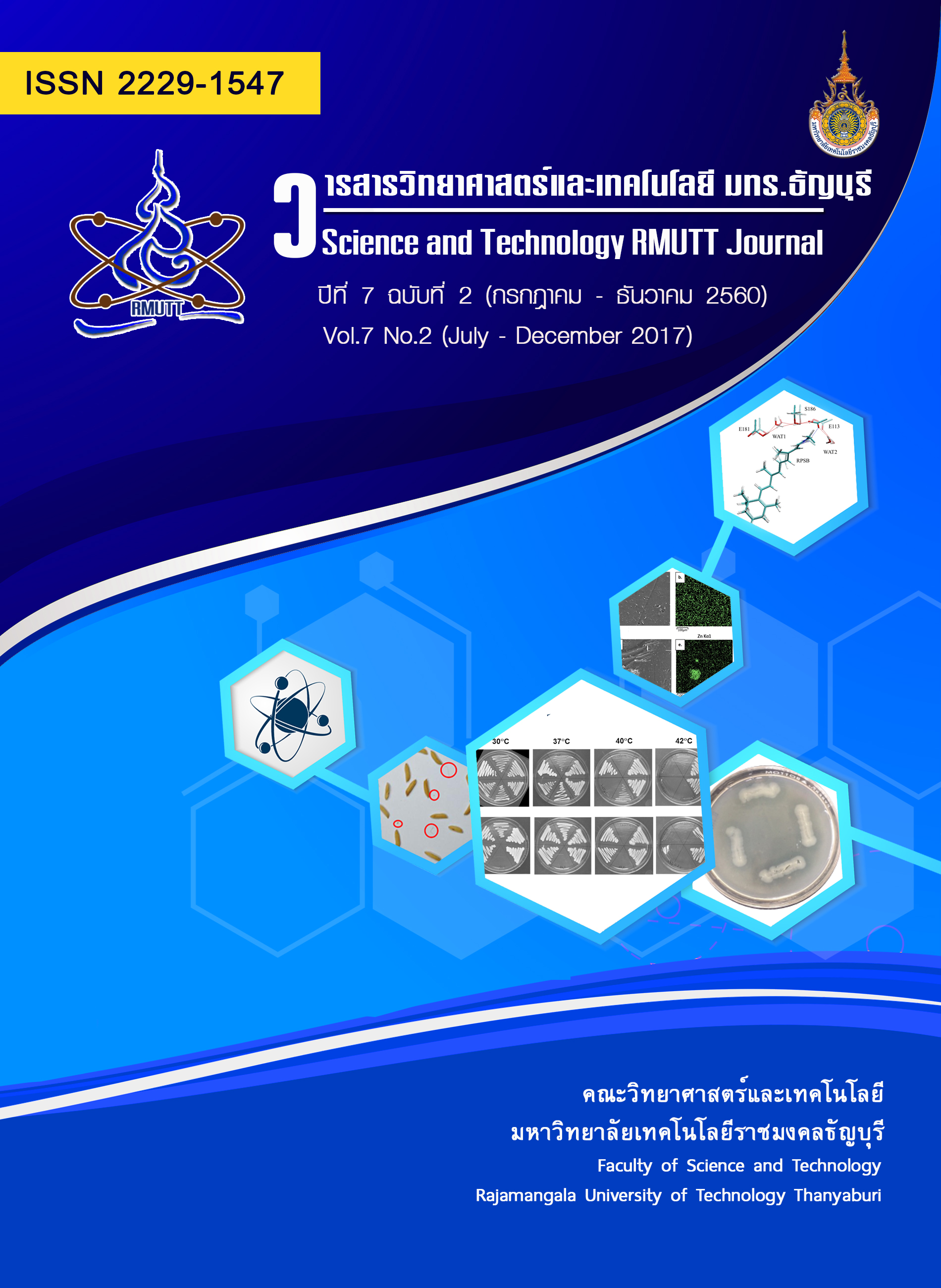Fractionation of Metals in Soil Surrounded Gold Mine at Phichit Province Using a Continuous-flow Sequential Extraction
Main Article Content
Abstract
Fractionation of metals is the important information to predict the mobility and bioavailability of metals in the environment. These data is used to estimate the degree of metals contamination. The main purpose of this study is to investigate the fractionation of Aluminium (Al), Cadmium (Cd), Copper (Cu), Iron (Fe), and Zinc (Zn) in soil surrounded gold mine at Phichit province using a continuous-flow sequential extraction. A five-stage sequential extraction procedure was performed to compare various fractions of these metals in different soil sample. These results showed that mostly metals at different direction and distance were from natural source except Cu, Fe, and Zn in soil at the route of L1-L3-L10. Their enrichment factor was higher than 1 indicating the anthropogenic source from human activity. Furthermore the fractionation of five metals except Zn could be divided into two groups affecting by transportation of gold mine. Considering Cu and Fe distribution, Cu fractionation at L1, L3, and L10 was contributed in water soluble and exchangeable phase whereas it was mostly occurred in oxidizable phase at R1, R3, R10, and C100. Therefore Cu at L1, L3, and L10 was more potentially labile into environment than others. However Fe fraction of both groups was mainly associated in residue phase indicating immobile or very stable.
Article Details
References
Lusilao-Makiese J.G., Cukrowska E.M., Tessier, E., Amouroux, D. and Weiersbye, I. The impact of post gold mining on mercury pollution in the West Rand region, Gauteng, South Africa. J. Geochem. Explor. 2013. 134 : 111-119.
Yin H., Tan N., Liu C., Wang J., Liang X., Qu M., Feng X., Qiu G., Tan W. and Liu F. The associations of heavy metals with crytalline iron oxides in the polluted soils around the mining areas in Guangdong Province, China. Chemosphere 2016. 161 : 181-189.
Huang X., Zhu Y. and Ji H. Distribution, speication, and risk assessment of selected metals in the gold and iron mine soils of the catchment area of Miyun Reservior, Beijing, China. Environ. Monit. Assess. 2013. 185 : 8525-8545.
Carvalho P.C.S., Neiva A.M.R. and Silva M.M.V.G. Assessment to the potential mobility and toxicity of metals and metalloids in soils contaminated by old Sb-Au and As-Au mines (NW Portugal). Environ. Earth Sci. 2012. 65 : 1215-1230.
Chomchoei R., Shiowatana J. and Pongsakul P. Continuous-flow system for reduction of metal readsorption during sequential extraction of soil. Anal. Chim. Acta 2002. 472 : 147-159.
Miró M., Hansen E.H., Chomchoei R. and Frenzel W. Dynamic flow-through approaches for metal fractionation in environmentally relevant solid samples. Trends Anal. Chem. 2005. 24(8) : 759-771.
Fu F.L. and Wang Q. Removal of heavy metal ions from wastewaters: a review. J. Environ. Manage. 2011. 92 : 407-418.
Tessier A., Campbell P.G.C. and Bisson M. Sequential extraction procedure for the speciation of particulate trace metals. Anal. Chem. 1979. 51 : 844-851.
Cheevaporn V. and San Diego-Mcglone M.L. Aluminium normalization of heavy metal data from estuarine and coastal sediments of the Gulf of Thailand. Thammasat Int. J. Sci Tech. 1997. 2 : 37-46.
Sutherland R.A. Bed sediment-associated trace metals in an urban stream, Oahu, Hawaii. Environ. Geol. 2000. 39 : 611-627.
Mohanraj R., Azeez P.A. and Priscilla T. Heavy metals in airborne particulate matter of urban coimbatore. Arch. Environ. Contam. Toxicol. 2004. 47 : 162-167.
Manoli E., Voutsa D. and Samara C. Chemical characterization and source identification / apportionment of fine and coarse air particles in Thessaloniki, Greece. Atmos. Environ. 2002. 36 : 949-961.
Zereini F., Alt F., Messerschmidt J., Wiseman C., Feldmann I., Bohlen A.V., Müller J., Liebl K. and Püttmann W. Concentration and distribution of heavy metals in urban airborne particulate matter in Frankfurt am Main, Germany. Environ. Sci. Technol. 2005. 39 : 2983-2989.
Likuku A.S., Mmolawa K.B. and Gaboutloeloe G.K. Assessment of heavy metal enrichment and degree of contamination around the copper-nickel mine in the Selebi Phikwe region, Eastern Botswana. Environ. Ecology Res. 2013. 1(2) : 32-40.
Li Q., Ji H., Qin F., Tang L., Guo X. and Feng J. Sources and the distribution of heavy metals in the particle size of soil polluted by gold mining upstream of Miyun Reservoir, Beijing: implications for assessing the potential risks. Environ. Monit. Assess. 2014. 186 : 6605-6626.
Aursalung A. The study of metal speciation during compost of pig manure with the sequential extraction technique: a case study of zinc and potassium. M.Sc. Thesis. Department of Environmental Science. Silpakorn University. 2015.
Tiyapongpattana W., Pongsakul P., Shiowatana J. and Nacapricha D. Sequential extraction of phosphorus in soil and sediment using a continuous-flow system. Talanta 2004. 62 : 765 – 771.
Cao F., Kong L., Yang L. and Zhang W. Geochemical fractions and risk assessment of trace elements in soils around Jiaojia gold mine in Shandong Province, China. Environ. Sci. Pollut. Res. 2015. 22 : 13496-13505.

